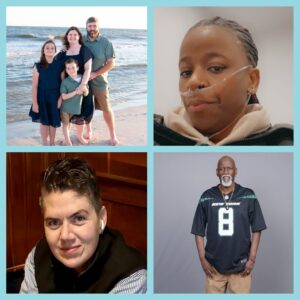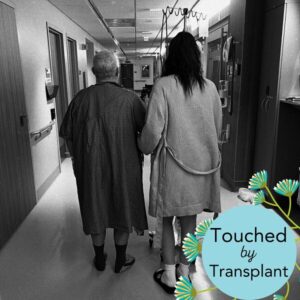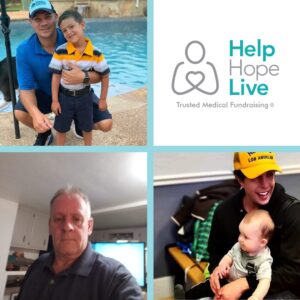Uniquely impacted by epilepsy, Jen Colello and Paige Marinelli were connected by chance—and united by hope.
Today, Paige is starting her climb of Mount Washington to raise hope, awareness, and funds for Help Hope Live in honor of Jen’s son, Andrew, who is living with epilepsy.

How did epilepsy first enter your life?
Jen: We knew about Andrew’s spina bifida while he was in utero, but epilepsy was a curveball that came our way when Andrew was 2 1/2 years old.
Epilepsy is particularly challenging because there is a spectrum of symptoms when living with epilepsy. For some people, their epilepsy doesn’t affect every aspect of their lives. Andrew’s epilepsy, even with all of his medications, is still not “controlled.”

Paige: Epilepsy became a part of my story at age 10. It has impacted me in so many ways throughout my life, bringing with it many hardships and many triumphs.
I still learn something new about epilepsy every day. I know my own case, but I agree that there is a spectrum.
For some people, epilepsy affects them minute-to-minute every day. Epilepsy impacted me more as a child. As I got older, I learned that a specific part of my brain was causing my seizures, but often, you have no idea where your symptoms are coming from or how to stop them.
I know we don’t often see epilepsy as a positive thing. However, I would not be the same individual with the same goals if it were not for my diagnosis and health journey.
Is the impact of epilepsy always visible?
Paige: Not at all. I am very involved with my community through jobs and volunteer work, and I’m working in my generalist practice for my master’s in social work at my local youth and family services office. I also coach soccer at multiple levels, run fitness classes, and have a health coaching practice. If you just saw my face, you would never know that I had epilepsy or that I have had four brain surgeries to manage it.

Jen: In many ways, Andrew still resembles a typical 5-year-old. Andrew’s goal in life is essentially to keep up with his old brother, Trey, and Trey’s cool, older friends—he’s very typical in that way! He loves superheroes and wrestling, and he can be rough and loud, but he also has his moments of being soft and cuddly.
Andrew: My favorite wrestler is John Cena, mostly.

Jen: To walk, he uses a mobility device and a low-profile bike—unless he’s in the bike, he has trouble keeping up with the other kids.
What you might not see looking at him is all the medications and supplements he takes. He vomits and gags very easily. He is in physical therapy throughout the week and sees lots of specialists, and he has frequent emergency room visits, bloodwork, MRIs, and other procedures. He also has to sleep in bed with us so we can monitor his seizures and oxygen levels.

How much does Andrew know about what makes him different?
Jen: He is more aware than most 5-year-olds, particularly when it comes to how he is different from other kids. He is extremely intelligent and observant. He has realized what epilepsy means in his life sooner than I expected him to—he can tell you what a seizure is and explain multiple aspects of his care.
As far as his spina bifida, we used to call him the spokesperson—ask about his braces and he would tell you exactly what they are and why he was wearing them. However, within the past year, he’s become a bit shyer and doesn’t want to talk about his mobility when someone asks.
We try to encourage him to think of his mobility aids the same way as a shorter person (I am 5 feet tall) would view a stepstool. Wouldn’t it be silly if I just refused to reach the top cabinet instead of using a stepstool when I needed one? He accepts that, but in public, it feels different for him.
He also has a large scar on his back where a lesion closed. While he is getting more self-conscious of it as he gets older, Rich and I kiss his scar—we think everything about him, including his scar, is perfect just the way it is.

How did you meet?
Paige: I volunteer with an epilepsy support group, which held a virtual meeting during COVID-19. I was helping to facilitate the group over Zoom when I met Jen.
We connected very quickly. We were drawn to each other’s energy, and I was able to empathize with some of her experiences as a parent as a 26-year-old who had been through my own childhood journey with epilepsy. I think it was important for her to see me and hear about my life—and in the process, to discover more hope for Andrew’s future.
Why did you consider getting a service dog for Andrew?
Jen: We knew that Andrew wanted, above all, to be independent. He is not able to sleep on his own right now, and an increase in medication has made him less physically steady and thrown off his balance. His mobility has taken a big hit, and that’s why we slowly began to think of a service dog not as a nice-to-have but as something that he needs.
A seizure alert dog can stay with him both during the day and while he sleeps. A lot of his seizures are focal, meaning that they affect one part of the brain. As a result, his experience with a seizure could be full-body, or it could be something as subtle as his left eye blinking rapidly. We know that we are missing some of these seizures, but an alert dog can bark to alert us of subtle or overnight seizures.
A service dog can provide physical support and prevent falls related to his seizure activity. We think a dog may also help socially—he tends to be very shy, especially in new situations.

When did fundraising enter the picture?
Jen: Health insurance does not cover the cost of a service dog at all. The agency we are currently looking at requires $17,000.
I was so nervous to begin—we don’t use social media in general, and we don’t like putting ourselves out there more than we have to. That’s where Paige came in.
Paige: When I learned about Andrew’s family’s interest in a service dog, I immediately said to another epilepsy support group facilitator, “Get me the information. I want to get him this dog.” I put some ideas together, and we shot a fundraising video in just two weeks. I’m not big on social media, either, but word spread like wildfire!
Jen: I got a call from a news reporter, and four hours later, we were on local TV. By the next morning, we were on NBC.
When Paige called and told us what she wanted to do with her Mount Washington climb, it was the push we needed to step out of our comfort zones.
Paige: We raised $20,000 in one week.

Jen: One of the biggest contributors to our success was Paige and I tapping into our respective communities in Old Saybrook and Trumbull. The majority of our support has come from those communities. Here in Trumbull, most of the donations have come from people who are connected to Andrew’s preschool or daycare, or from Trey’s school, which Andrew will be attending this fall.
One friend is an artist who donated artwork. Another is making t-shirts for the hike and plans to give them out to some of our biggest supporters.
One amazing thing about fundraising is that once we did put ourselves out there, our friends and neighbors celebrated the fact that we had finally asked for—and accepted—financial help. They are good people who wanted to help but just didn’t know how. They thanked us for providing them with a way to help.
There were other benefits, too: this journey has been such a family effort, and sometimes, I think that Trey is the forgotten soldier in all this. We do our best to make him feel important, but after the fundraising video came out, a lot of his friends and classmates were also able to recognize and truly celebrate what a good big brother he is to Andrew.

Why did you choose Help Hope Live?
Jen: We first used Help Hope Live when Andrew was a baby to help with out-of-pocket costs—we were introduced by another Help Hope Live client who is living with a severe spinal cord injury. We liked the idea of continuing to fundraise with Help Hope Live for this service dog push.
What is most important to us is that Help Hope Live gives donors confidence that donations will be held securely and will only be used to cover their intended medically-related purposes.
Why climb Mount Washington as part of those fundraising efforts?

Paige: I think there is a misconception that if you have epilepsy, you cannot have a good quality of life or achieve what you want to. Many people around you, including some of the people you love most, become nervous and even restrictive to help protect your safety.
I had four surgeries when I was 23. I’m 26 now, and as of last month, I have officially been seizure-free for three years. As I go through my life, there is always a part of me saying, “Maybe I shouldn’t do this. It will be too hard or too strenuous.” But there is another voice in me, and it says, “No—I CAN do this. Watch me do it!”
There was always something about climbing Mount Washington that represented that to me. I have wanted to make the climb for some time now to prove that I am capable of doing it and to raise awareness—now there is another side of my climb to provide hope and financial help to another epilepsy family.
I am climbing Mount Washington in Andrew’s name, but I am climbing for all those with epilepsy and other disorders who are looking for hope. Epilepsy can have a voice—it needs one.
How does awareness tie into this effort?
My goal, above all, is to advocate and raise awareness for people living with epilepsy. I think the public is not educated enough on epilepsy, and there is a lot of fear, confusion, and uncertainty surrounding it. There are so many misconceptions. It is easy to become more aware, but the public doesn’t come across epilepsy resources very often.
One in 100 people has epilepsy. One in 10 will have a seizure within their lifetime. Despite these facts, did you know that in a general first aid class, epilepsy isn’t mentioned?
I did my master’s research project on epilepsy. One particular finding stood out to me: in a study, the majority of local preschool teachers said they would feel uncomfortable if a child in their care had a seizure or displayed a symptom of epilepsy. They reported that they did not know exactly how they would respond if it happened.
It’s a simple routine to respond to epilepsy or a seizure. Still, because so few people know this, they are often scared—especially when on TV and in the movies, seizures are always a big, dramatic, and frightening event that make everyone in the scene anxious or afraid.
With this climb, I believe that one tiny act will allow us to continue to get the word “epilepsy” in the news.
What does hope mean to each of you?
Jen: Andrew has so much to offer the world. He is determined, smart, and funny, and he has wisdom beyond his age. When he was first born, we looked at each other and said, “This kid will do great things.” His prognosis was that he would never move his legs, and he came out kicking—he has defied the odds since he was less than one day old.
As parents, first and foremost, we want him to be happy—but we also want him to be independent, because we know that’s what he wants to be. We want to see him live up to his potential. That’s what hope means to us.

Paige: Through simple acts of kindness, we can make a huge impact in ways that we never expected. This is a story of hope in so many ways. Hope may be a service dog for Andrew, life-changing surgery for me, and community support for Andrew’s family and so many others living with epilepsy.
Hope is a voice for a disorder that is misunderstood and underrepresented. And hope is the fact that we believe the steps we’re taking together today are just the beginning of giving epilepsy its voice.
Andrew, are you excited about your service dog?
Andrew: Dogs are very nice and I like them. My dog’s name will be Parker after Peter Parker because I love Spider-man.
Can you please tell us one of your best knock-knock jokes?
Andrew (with help from Trey):
-Knock, knock.
-Who’s there?
-Banana.
-Banana who?
-Knock, knock.
-Who’s there?
-Banana.
-Banana who!?
-Knock, knock.
-Who’s there?
-Orange.
-Orange who?
-Orange you glad I didn’t say Banana?
Yes, we are—thank you, Andrew! You can follow Andrew’s story at helphopelive.org.
Written by Emily Progin










